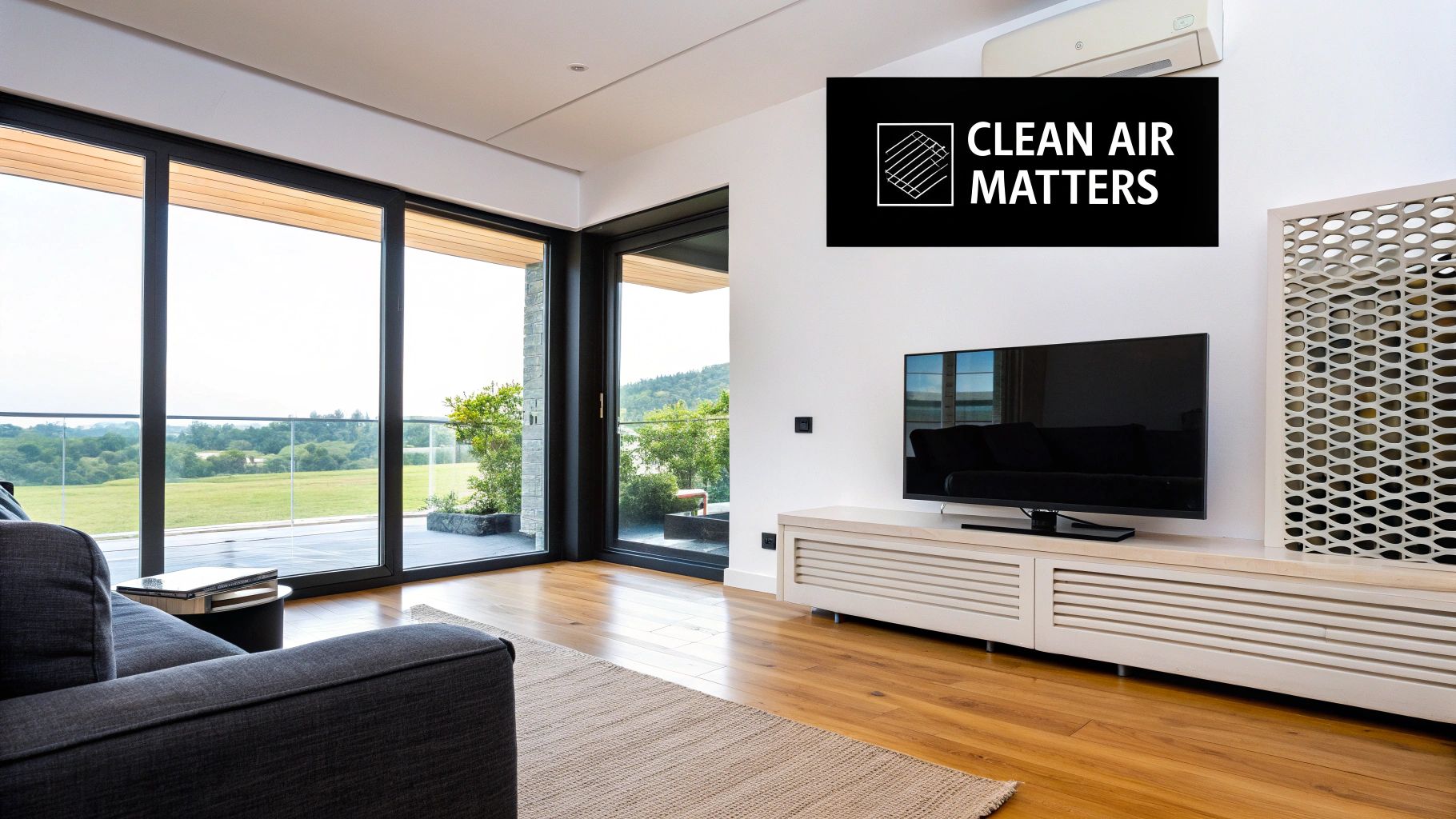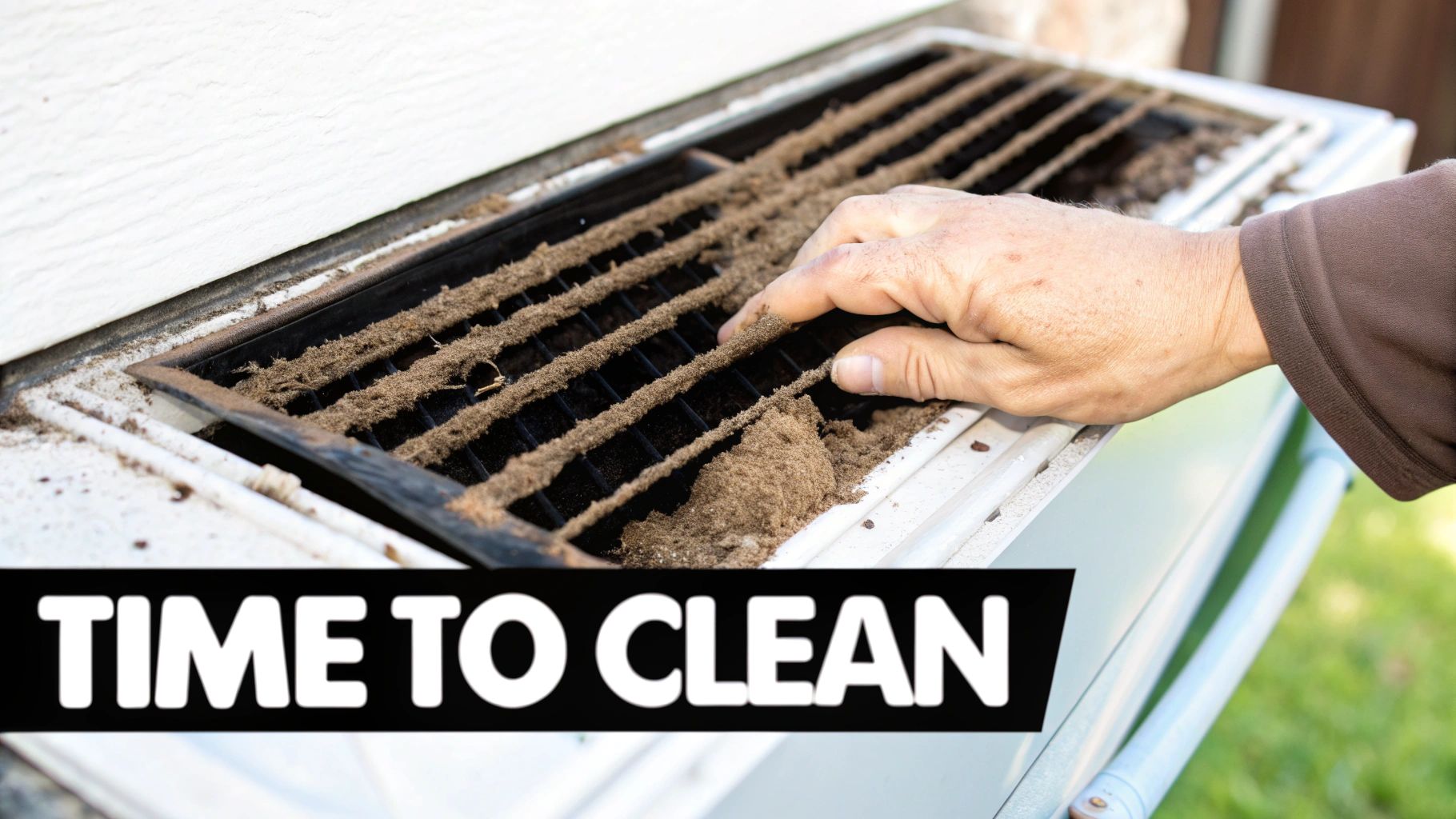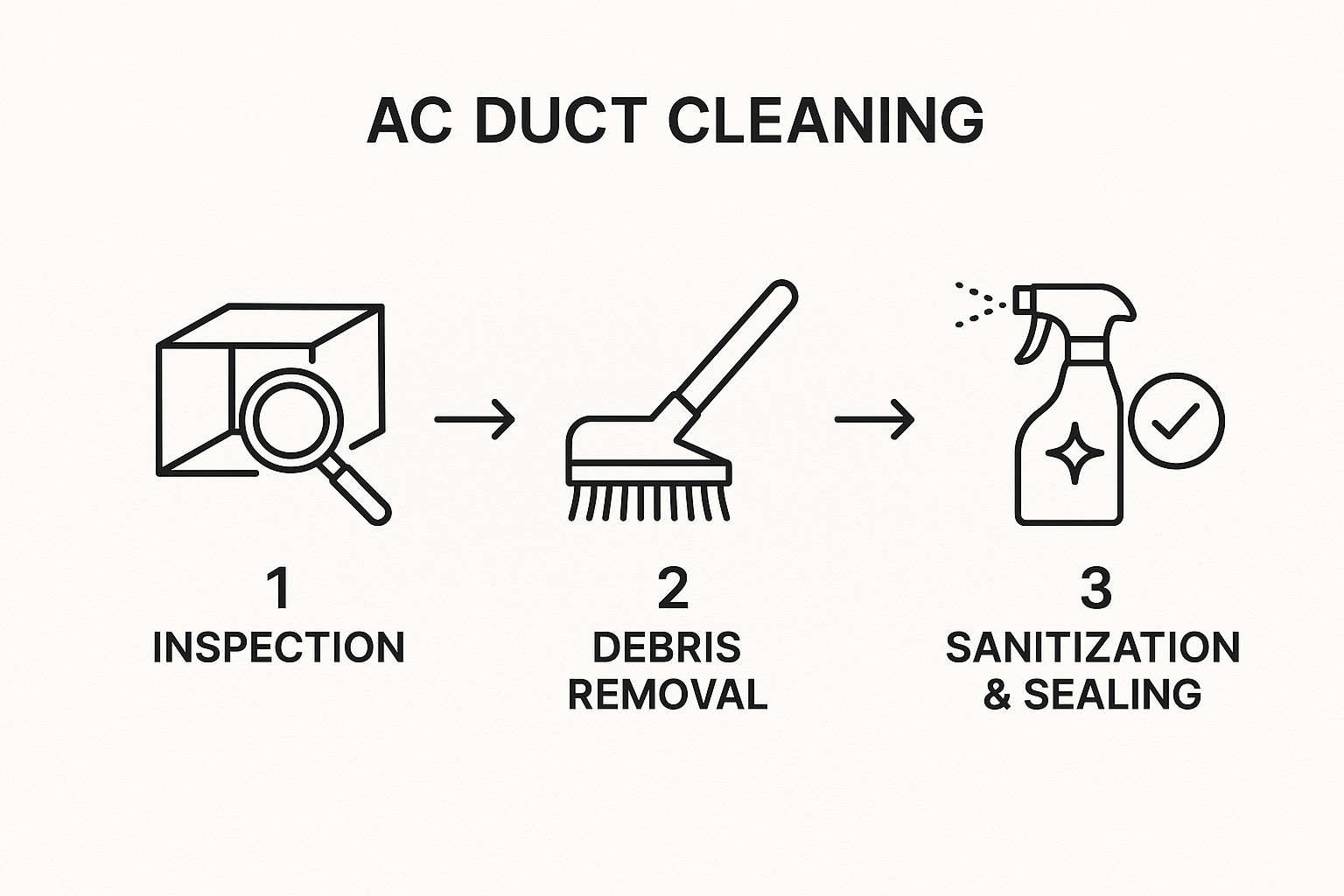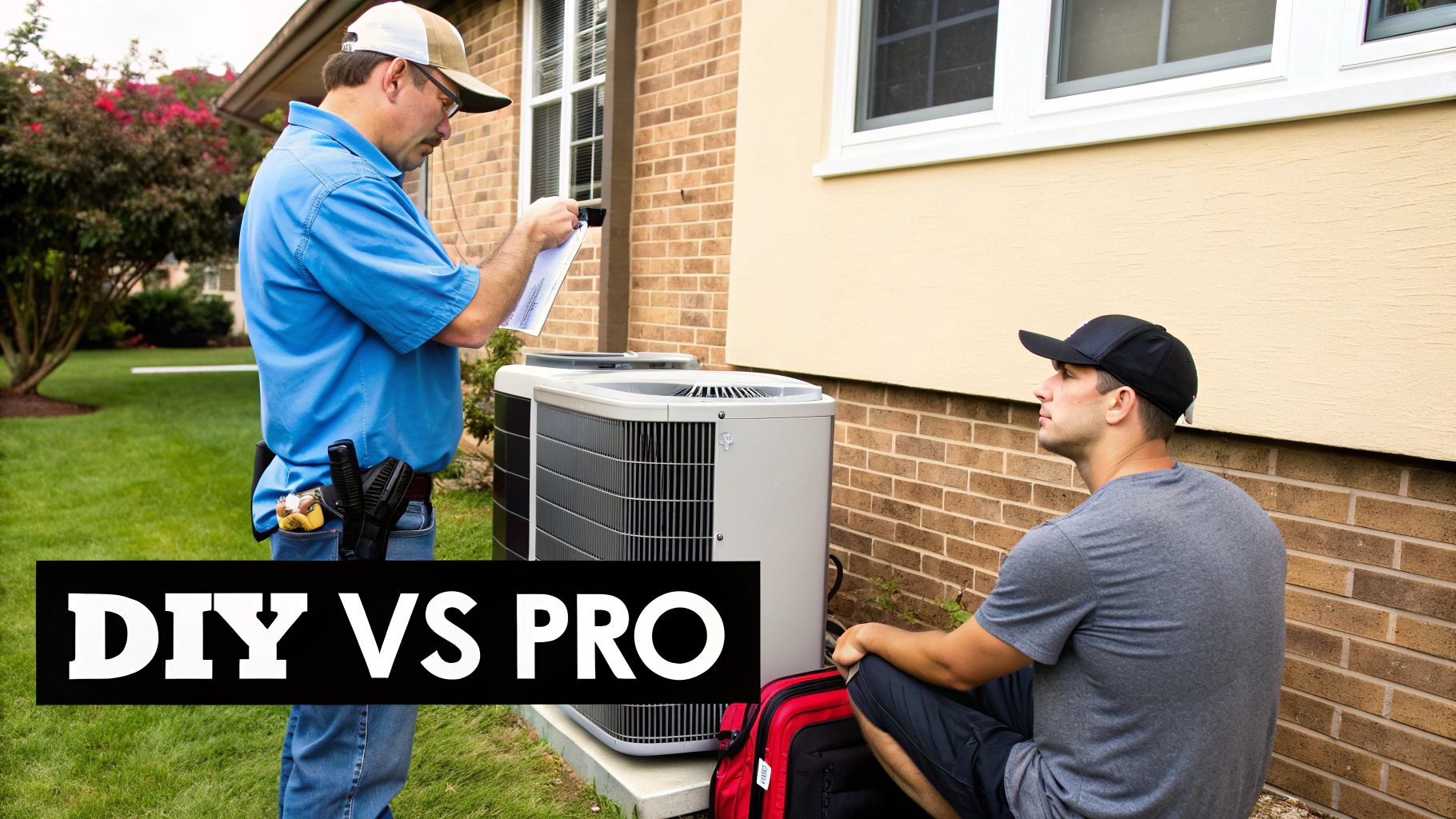That stuffy feeling you get at home isn't just your imagination—it's likely what’s circulating through your air vents. The process of air conditioning cleaning ducts involves removing all the built-up dust, allergens, and other gunk from your HVAC system’s ductwork. Taking this step is one of the best things you can do to improve your home's air quality, boost your system’s efficiency, and even trim down your energy bills.
Why Cleaning Your AC Ducts Actually Matters

It’s easy to forget about your home's ductwork. Since it’s tucked away behind walls and ceilings, it’s a classic case of "out of sight, out of mind." But these hidden channels are essentially the lungs of your home, circulating the air you and your family breathe day in and day out. Over time, they become a collection point for everything from simple household dust to more serious contaminants.
For a lot of homeowners, the lightbulb moment comes when they notice a real dip in their indoor air quality. Maybe you're seeing dust settle on furniture just a day or two after cleaning, or perhaps a family member's allergies suddenly seem much worse inside the house. It's no coincidence. Every time your AC or furnace kicks on, it's pushing those accumulated particles right back into your living space.
This airborne mess can include all sorts of irritants:
- Pet Dander: A major trigger for many people with allergies.
- Pollen and Dust Mites: These tiny particles are notorious for causing asthma and allergy flare-ups.
- Construction Debris: If you've renovated recently, leftover drywall dust and sawdust can get trapped and circulate for years.
- Microbial Growth: In damp conditions, mould and mildew can thrive in the dark, undisturbed environment of your ductwork.
The Connection Between Clogged Ducts and High Energy Bills
Beyond just the air you breathe, dirty ducts can hit you right in the wallet. Your HVAC system is engineered to move a certain amount of air. When layers of dust and debris start to clog the passageways, your system has to work overtime just to push the air through. Think of it like trying to breathe through a clogged-up straw—it takes a lot more effort for a lot less result.
This extra strain doesn't go unnoticed. The U.S. Department of Energy figures that 25% to 40% of the energy you use for heating and cooling is simply wasted when airflow is blocked. That inefficiency shows up directly on your monthly utility bills. In fact, a study from the National Renewable Energy Laboratory (NREL) found that clogged ducts can slash airflow by 15%, causing a staggering 21% spike in energy consumption.
The National Air Duct Cleaners Association (NADCA) has a shocking statistic: an incredible 90% of HVAC system failures are caused by a buildup of dirt and debris. Regular cleaning isn't just about being tidy; it's about protecting one of your home’s most critical and expensive appliances.
Spotting the Signs Your Ducts Need Attention
So, when is it time to tackle an air conditioning cleaning ducts project? A professional inspection will always give you the clearest answer, but there are definitely some tell-tale signs you can look for yourself.
One of the most obvious clues is seeing little puffs of dust shoot out of the supply vents when your system turns on. You might also notice dark marks, sometimes called "ghosting," on the walls, ceilings, or carpet around the registers. If there's a persistent musty or stale smell that you can't seem to track down, especially when the AC is running, that's another big red flag. If you find yourself asking how frequently this task is needed, our guide provides detailed timelines and recommendations on https://candoductcleaning.com/blog/how-often-to-clean-air-ducts.
Catching these signs early lets you take action before small problems turn into big, expensive ones. A clean duct system means a healthier home, a more efficient HVAC system, and real savings on your energy costs.
Assembling Your Duct Cleaning Toolkit

You know how it goes—you start a home project, get halfway through, and realize you're missing a crucial tool. When it comes to air conditioning cleaning ducts, showing up unprepared doesn't just waste your weekend; it can actually damage your HVAC system or compromise your safety.
Forget about using your regular household vacuum. The caked-on dust, allergens, and mystery gunk hiding in your ductwork demand some serious power. You need the right gear to break it all loose and suck it up for good without just blowing it all over the house.
The Heavy Lifters: Core Cleaning Equipment
The absolute MVP of this job is a powerful shop vacuum. You'll want one with a beefy motor and a long, flexible hose that can snake deep into the registers. The most important feature, though, is a HEPA filter. Without it, you're just kicking up the finest, most irritating particles and sending them airborne again.
Next up are the specialized duct cleaning brushes. These aren't your typical scrub brushes. They’re designed with long, bendy handles and soft bristles that can scour the inside of your ducts without ripping them. This is especially critical for flexible duct lines, where a stiff brush can easily cause a tear and a costly repair call.
From experience, a shop vac with at least 5 horsepower is what you'll need for a typical single-family home. It provides enough suction to clear debris from one end of the duct to the other. Anything less powerful just cleans the first few feet and leaves the real problem untouched.
Safety First: Your Personal Protective Gear
Let's be clear: this part is not optional. The stuff you're about to stir up has been accumulating for years and can include mould spores, dust mites, and who-knows-what-else. Protecting yourself is non-negotiable.
Here’s your must-have safety kit:
- A High-Quality Mask: Don't even think about a simple dust mask. You need an N95-rated respirator, which filters out 95% of airborne particles, to properly protect your lungs.
- Safety Goggles: When you're working on ceiling vents, gravity is not your friend. Goggles are essential for keeping dust and falling debris out of your eyes.
- Gloves: A decent pair of work gloves will save your hands from the surprisingly sharp metal edges of vent covers and ductwork.
Before you start pulling things apart, it's a good idea to have your full toolkit ready to go. Here's a quick checklist of the essentials and some helpful extras.
DIY Duct Cleaning Tool Checklist
| Tool | Purpose | Why It's Necessary |
|---|---|---|
| Shop Vacuum | Sucking up dislodged dust and debris | Needs strong suction and a long hose to reach deep into the ducts. Your household vacuum isn't powerful enough. |
| HEPA Filter | Trapping fine particles | Prevents the smallest, most harmful allergens from being recirculated back into your home's air. |
| Duct Brush Kit | Scrubbing interior duct surfaces | Flexible, long-handled brushes are designed to clean without damaging delicate or flexible ductwork. |
| N95 Respirator | Protecting your lungs | Filters out fine dust, mould spores, and other irritants you'll inevitably kick up. |
| Safety Goggles | Shielding your eyes | Protects against falling debris, especially when working on ceiling vents. |
| Work Gloves | Protecting your hands | Prevents cuts and scrapes from sharp sheet metal edges on vents and duct openings. |
| Screwdriver/Drill | Removing vent covers | Needed to take off and re-install all the supply and return registers in your home. |
| Painter's Tape | Sealing off other vents | Concentrates the vacuum's suction on one duct at a time, making your cleaning far more effective. |
Having these items on hand will make the entire process smoother and ensure you get the job done right the first time.
The Little Things That Make a Big Difference
Beyond the big-ticket items, a few simple supplies will make your life much easier. Grab a screwdriver or a drill to pop off the vent covers (also known as registers). A pro tip: use small resealable bags to hold the screws for each vent so you don't lose them.
Finally, keep a roll of paper towels and some painter's tape nearby. As you work on one vent, use the tape to seal off the other vents in the same room. This simple trick forces the vacuum's suction to pull exclusively from the duct you're cleaning, making a massive difference in its effectiveness.
The DIY Guide to Cleaning Your Air Ducts
Alright, you’ve gathered your tools and suited up in your safety gear. Now comes the hands-on part. The actual process of air conditioning cleaning ducts isn't rocket science, but it absolutely requires a patient and methodical hand. If you rush, you risk a poor cleaning job or, worse, damaging your ductwork. So, take a deep breath and let's walk through this properly.
First thing’s first, and this is non-negotiable: completely shut off the power to your HVAC system. I don’t just mean flipping the thermostat to "off." Head to your main electrical panel and kill the breaker for both the furnace and the air conditioner. This is the single most critical safety step to prevent the system from kicking on while your hands are inside.
Prepare Your Workspace
Before you even think about unscrewing a vent cover, lay down some drop cloths or old sheets around the area. This job is going to kick up dust—it's inevitable. A little prep work here will save you a massive cleanup headache later. If you've got furniture nearby, now's the time to move it or cover it up.
With your area protected, grab your screwdriver or drill and start removing the vent covers (also called registers). Work one room at a time, taking off both the supply and return vent covers. Here’s a pro tip: put the screws from each vent into a separate, labelled plastic baggie. It sounds like a small thing, but you’ll thank me when you're not trying to figure out which screw goes where during reassembly.
The Initial Cleaning Phase
Take those grimy registers outside or to a utility sink. Give them a good scrub with warm, soapy water and a soft brush—you’ll be amazed at the gunk that comes off. Let them air dry completely while you tackle the ducts.
Now, it's time for your shop vacuum. With a long hose and a brush or crevice tool attached, vacuum as far as you can reach inside each duct opening. You'll immediately pull out a surprising amount of loose dust, pet hair, and maybe even a few long-lost treasures (like those missing Lego pieces). This first pass clears out the easy stuff and gets the ducts ready for a deeper scrub.
This infographic lays out the key stages for a successful duct cleaning project.

As you can see, a proper clean is more than just a quick vacuum. It involves a systematic approach: inspection, active debris removal, and careful finishing.
Maximizing Suction for a Deeper Clean
Want to really boost your vacuum's effectiveness? Here’s a trick the pros use. As you work on one specific duct, use painter's tape or cardboard to seal off the other supply vents in that same area. By blocking off the other escape routes, you force all the suction power through the one duct you're cleaning. It makes a huge difference.
This simple technique mimics the powerful negative air pressure systems professionals use, just on a smaller scale. It’s what separates a light surface dusting from a genuinely effective deep clean.
With the other vents sealed, you're ready to dislodge the really stubborn, caked-on dust that a vacuum alone can't handle.
Agitating and Removing Stubborn Debris
This is where your specialized duct cleaning brush earns its keep. Keep the shop vacuum running with the hose placed firmly in the duct opening. Now, carefully feed the long, flexible brush into that same duct. Your goal is to scrub the interior walls.
Work the brush back and forth, twisting and turning it to loosen grime from every surface. Because the vacuum is running constantly, it will suck up the debris as soon as you break it free, preventing it from settling somewhere else. Push the brush in as far as you can, then slowly work it back out, continuing the scrubbing motion the entire time.
You need to repeat this for every single supply and return vent in your house. Yes, it's tedious, but consistency is everything. Your ductwork is one big, interconnected system, so cleaning just a couple of vents won't do much for your home's overall air quality. To get a better handle on how this system works, check out our comprehensive guide on air ventilation cleaning.
Finishing Touches and Reassembly
Once you’ve brushed and vacuumed every last duct, you're on the home stretch. Do one final pass with the vacuum around each duct opening to catch any last-minute debris before you put the covers back on.
Go grab your clean, dry vent covers. Carefully screw each one back into its original spot, using the screws you smartly saved in those labelled bags. Tighten them until they're snug, but don’t go overboard—you don't want to crack the drywall.
Pull off all the painter's tape you used to seal the other vents. Now, head back to the electrical panel and flip the HVAC breaker back on. The very last step is to turn on your system’s fan (just the fan, no heat or AC) for about 10-15 minutes. This will blow out any fine dust that might have settled. Take a quick walk around the house to make sure air is flowing from all the vents, and you're done. Your DIY duct cleaning is complete
Avoiding Common DIY Duct Cleaning Mistakes
When it comes to a DIY air conditioning cleaning ducts project, what you don't do is just as important as what you do. It's easy to get excited and jump right in, but a little bit of know-how can prevent a simple weekend task from spiraling into a costly headache. Let's walk through the common stumbles I've seen homeowners make, so you can sidestep them entirely.
One of the biggest oversights is skimping on personal protective equipment. The gunk inside your ducts isn't just harmless dust bunnies. It's a nasty cocktail of dust mites, pet dander, pollen, and maybe even mould spores that have built up over years.
Kicking all that into the air without the right gear is just asking for respiratory problems. You absolutely need an N95-rated mask—a simple paper one won't cut it. Safety goggles are another must-have, especially when you're working directly under ceiling vents. Trust me, you don't want that stuff falling into your eyes.
Using the Wrong Tools for the Job
This is probably where most DIY jobs go sideways. It’s tempting to just find a brush in the garage and go for it, but if that tool is too stiff, you can do some serious damage. This is especially true for the flexible duct lines found in many newer homes.
A rigid brush can easily tear or poke holes in the thin walls of flex ducts. Suddenly, you've created leaks that not only tank your HVAC system's efficiency but also start pulling dirty, unconditioned air from your attic or crawlspace right back into your home. The solution? Stick to brushes made specifically for ductwork; they have the soft bristles and flexibility needed to do the job safely.
I once heard from a homeowner who thought a chimney-sweeping brush would work on his flex ducts. He ended up with dozens of tiny rips and had to replace the entire line. That’s a multi-thousand-dollar mistake that could have been avoided by just using the right tool.
Failing to Properly Reseal Vents
You’ve done all the hard work, and now you’re on the home stretch—putting the vent covers back on. This is where people tend to rush, and it's a critical mistake. Every single vent cover, or register, needs to form an airtight seal against the wall, floor, or ceiling.
Even tiny gaps can create a surprising number of issues:
- Air Leaks: Your expensive conditioned air will bleed into the wall cavities instead of the room, wasting energy.
- Whistling Noises: Air being squeezed through a small opening can create a constant, annoying whistle whenever your system kicks on.
- Re-Contamination: Gaps around return vents will suck unfiltered dust from inside your walls right back into the system you just cleaned.
Take your time with this final step. Make sure each cover sits perfectly flush and is screwed in securely—but don't overtighten and crack the drywall. A good seal is non-negotiable for keeping your system efficient and clean.
Falling for the "Too Good to Be True" Shortcut
Finally, don't fall for a quick fix if you start feeling overwhelmed. You'll see ads online for "miracle" sprays or fogs that promise to clean your ducts with zero effort. Be very skeptical. Most of these products don't work, and some can even spray harmful chemicals throughout your home.
Real duct cleaning requires two things: physical agitation to loosen debris and a powerful vacuum to remove it. There are no magic wands here. This same caution applies if you decide to hire a professional instead; you need to be aware of how illegitimate companies operate. Arm yourself with knowledge by reading our guide on how to avoid duct cleaning scams.
Knowing When to Hire a Professional

While the DIY approach we've covered is fantastic for routine maintenance, it’s just as important to recognize its limits. Some situations involving air conditioning cleaning ducts are simply too complex or hazardous for a weekend project. Knowing when to put down the shop vac and call in a certified technician can save you from costly mistakes, potential health risks, and an ineffective cleaning job.
Think of it this way: a DIY clean is like tidying up the surface, while a professional service is a deep, restorative clean. Your efforts can certainly manage the light layers of dust that accumulate over a year or two. But there are several red flags that signal a problem beyond the scope of household tools.
Clear Signs It's Time to Call an Expert
Certain discoveries should immediately have you reaching for the phone. These aren't issues you can safely or effectively resolve on your own, and trying could easily make matters much worse.
Keep an eye out for these definitive signs:
- Visible Mould Growth: If you see any fuzzy black, green, or white patches inside your ducts or on your vent covers, stop what you’re doing. Disturbing mould without proper containment can release millions of spores into your home, creating a serious health hazard.
- Pest Infestation: Finding droppings, nests, or deceased rodents and insects in your ductwork is a clear signal to call for backup. Professionals have the right gear to remove these biohazards and properly sanitize the area, eliminating lingering bacteria and odours.
- Excessive Debris: If your ducts are so clogged that even a powerful shop vac barely makes a dent, you’ve met your match. Years of neglect, especially after a major home renovation, can lead to compacted debris that only commercial-grade equipment can dislodge.
A professional duct cleaning service doesn't just use a more powerful vacuum; they use a technique called "negative pressure." This involves sealing your entire system and using a massive, truck-mounted vacuum to create suction throughout the whole network. The key benefit? It ensures no dust or contaminants escape back into your home during the cleaning.
The Professional Toolkit and What to Expect
Certified technicians show up with specialized equipment that’s worlds away from what you can find at the local hardware store. They use high-powered vacuums, compressed air tools, and long, flexible rotating brushes to scrub every inch of your ductwork thoroughly and safely. This level of cleaning is absolutely essential for older homes or systems that haven't been serviced in many years.
The investment for this level of service reflects the specialized equipment and expertise involved. For example, in the San Francisco Bay Area, professional air duct cleaning for a typical single-family home generally ranges from $450 to over $1,000. This comprehensive price usually covers the cleaning of all supply and return ducts, registers, coils, and the air handling unit itself. Of course, the final cost will vary based on your home's size and the system's complexity.
Ultimately, deciding to hire a professional is about making sure the job is done right, especially when you’re dealing with serious contaminants. For a deeper dive into what a full-service cleaning involves, our homeowner's guide to residential duct cleaning provides more valuable insights. Making an informed decision ensures your home's air is not just clean, but truly healthy.
Frequently Asked Questions About Duct Cleaning
Even after going through all the steps, it's completely normal to have a few questions pop up about air conditioning cleaning ducts. Let's tackle some of the most common ones we hear from homeowners, so you can move forward with confidence.
How Often Should I Clean My Air Ducts?
A good baseline for most homes is a professional cleaning every three to five years. But that's just a starting point. Life happens, and some situations call for more frequent attention.
You'll want to think about cleaning them more often—maybe even annually—if your home has:
- Pets that shed a lot (hello, golden retrievers!).
- Anyone with significant allergies or respiratory issues like asthma.
- An indoor smoker.
- Just gone through a major renovation that kicked up a ton of dust.
Where you live matters, too. For example, homeowners in California’s Central Valley have to deal with both wildfire smoke and agricultural dust. Local experts stress that if you see visible mould or clouds of dust puffing from your vents, it's definitely time for a clean. You can read more about duct cleaning benefits in challenging air quality regions on blandcompany.com.
Can Cleaning Air Ducts Really Lower My Energy Bill?
Yes, it absolutely can, and sometimes quite a bit. Think of it this way: when your ducts are caked with dust and debris, it's like trying to breathe through a clogged straw. Your HVAC system has to fight against that resistance to push air through your home, and that extra effort burns more energy.
Cleaning out all that gunk opens up the airway. Your system can finally breathe easy and operate the way it was designed to, which often leads to a welcome drop in your monthly energy bills.
A clean HVAC system is an efficient one. Reducing the strain on your blower motor and fan not only saves energy but can also help extend the lifespan of these critical and expensive components.
Is It Possible to Damage My Ducts While Cleaning Them?
Unfortunately, the answer is yes. It's a real risk if you're not careful. This is especially true for modern flexible ductwork, which is essentially a delicate plastic liner protected by insulation. It doesn't take much—an overly aggressive brush or a sharp vacuum attachment—to tear or puncture it.
If you’re attempting a DIY clean, always use a soft-bristled brush made specifically for ductwork. Be gentle and methodical. If you have older ducts that might be brittle, or if you’re just not feeling confident, your best bet is to call a professional. It's the safest choice. Time is also a factor; you can learn more about how long a professional duct cleaning takes in our detailed article.
At Can Do Duct Cleaning, our trained technicians conduct a complete on-site inspection to ensure the safest, most effective approach for your home's specific system. Get your free estimate today.


